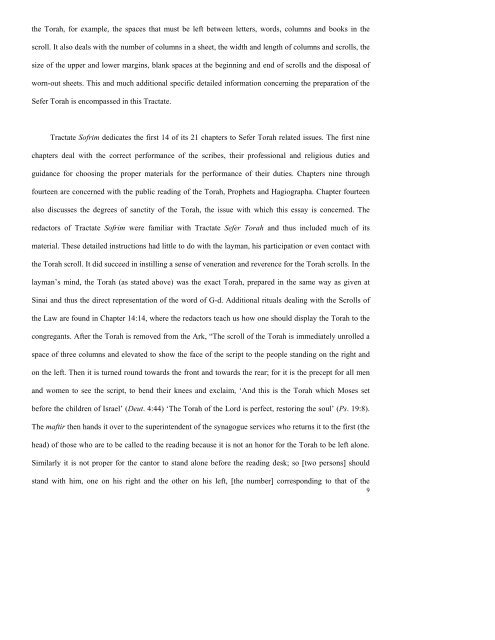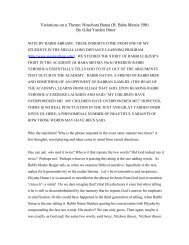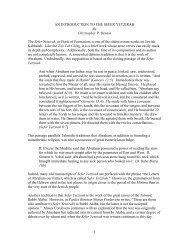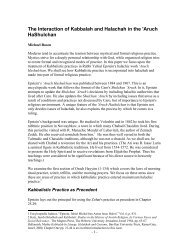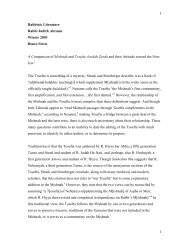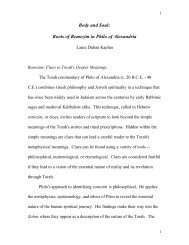The Symbolic Representation of the Sefer Torah - Maqom
The Symbolic Representation of the Sefer Torah - Maqom
The Symbolic Representation of the Sefer Torah - Maqom
You also want an ePaper? Increase the reach of your titles
YUMPU automatically turns print PDFs into web optimized ePapers that Google loves.
<strong>the</strong> <strong>Torah</strong>, for example, <strong>the</strong> spaces that must be left between letters, words, columns and books in <strong>the</strong>scroll. It also deals with <strong>the</strong> number <strong>of</strong> columns in a sheet, <strong>the</strong> width and length <strong>of</strong> columns and scrolls, <strong>the</strong>size <strong>of</strong> <strong>the</strong> upper and lower margins, blank spaces at <strong>the</strong> beginning and end <strong>of</strong> scrolls and <strong>the</strong> disposal <strong>of</strong>worn-out sheets. This and much additional specific detailed information concerning <strong>the</strong> preparation <strong>of</strong> <strong>the</strong><strong>Sefer</strong> <strong>Torah</strong> is encompassed in this Tractate.Tractate S<strong>of</strong>rim dedicates <strong>the</strong> first 14 <strong>of</strong> its 21 chapters to <strong>Sefer</strong> <strong>Torah</strong> related issues. <strong>The</strong> first ninechapters deal with <strong>the</strong> correct performance <strong>of</strong> <strong>the</strong> scribes, <strong>the</strong>ir pr<strong>of</strong>essional and religious duties andguidance for choosing <strong>the</strong> proper materials for <strong>the</strong> performance <strong>of</strong> <strong>the</strong>ir duties. Chapters nine throughfourteen are concerned with <strong>the</strong> public reading <strong>of</strong> <strong>the</strong> <strong>Torah</strong>, Prophets and Hagiographa. Chapter fourteenalso discusses <strong>the</strong> degrees <strong>of</strong> sanctity <strong>of</strong> <strong>the</strong> <strong>Torah</strong>, <strong>the</strong> issue with which this essay is concerned. <strong>The</strong>redactors <strong>of</strong> Tractate S<strong>of</strong>rim were familiar with Tractate <strong>Sefer</strong> <strong>Torah</strong> and thus included much <strong>of</strong> itsmaterial. <strong>The</strong>se detailed instructions had little to do with <strong>the</strong> layman, his participation or even contact with<strong>the</strong> <strong>Torah</strong> scroll. It did succeed in instilling a sense <strong>of</strong> veneration and reverence for <strong>the</strong> <strong>Torah</strong> scrolls. In <strong>the</strong>layman’s mind, <strong>the</strong> <strong>Torah</strong> (as stated above) was <strong>the</strong> exact <strong>Torah</strong>, prepared in <strong>the</strong> same way as given atSinai and thus <strong>the</strong> direct representation <strong>of</strong> <strong>the</strong> word <strong>of</strong> G-d. Additional rituals dealing with <strong>the</strong> Scrolls <strong>of</strong><strong>the</strong> Law are found in Chapter 14:14, where <strong>the</strong> redactors teach us how one should display <strong>the</strong> <strong>Torah</strong> to <strong>the</strong>congregants. After <strong>the</strong> <strong>Torah</strong> is removed from <strong>the</strong> Ark, “<strong>The</strong> scroll <strong>of</strong> <strong>the</strong> <strong>Torah</strong> is immediately unrolled aspace <strong>of</strong> three columns and elevated to show <strong>the</strong> face <strong>of</strong> <strong>the</strong> script to <strong>the</strong> people standing on <strong>the</strong> right andon <strong>the</strong> left. <strong>The</strong>n it is turned round towards <strong>the</strong> front and towards <strong>the</strong> rear; for it is <strong>the</strong> precept for all menand women to see <strong>the</strong> script, to bend <strong>the</strong>ir knees and exclaim, ‘And this is <strong>the</strong> <strong>Torah</strong> which Moses setbefore <strong>the</strong> children <strong>of</strong> Israel’ (Deut. 4:44) ‘<strong>The</strong> <strong>Torah</strong> <strong>of</strong> <strong>the</strong> Lord is perfect, restoring <strong>the</strong> soul’ (Ps. 19:8).<strong>The</strong> maftir <strong>the</strong>n hands it over to <strong>the</strong> superintendent <strong>of</strong> <strong>the</strong> synagogue services who returns it to <strong>the</strong> first (<strong>the</strong>head) <strong>of</strong> those who are to be called to <strong>the</strong> reading because it is not an honor for <strong>the</strong> <strong>Torah</strong> to be left alone.Similarly it is not proper for <strong>the</strong> cantor to stand alone before <strong>the</strong> reading desk; so [two persons] shouldstand with him, one on his right and <strong>the</strong> o<strong>the</strong>r on his left, [<strong>the</strong> number] corresponding to that <strong>of</strong> <strong>the</strong>9


